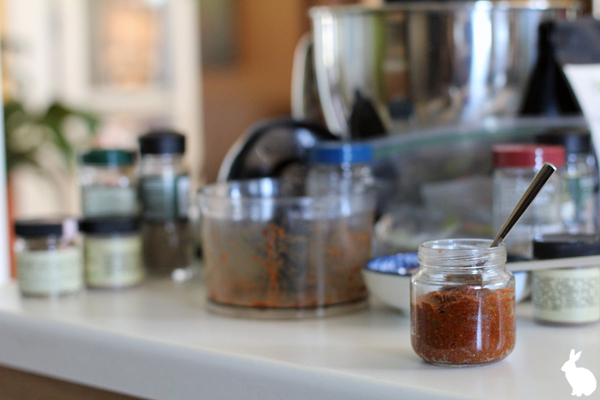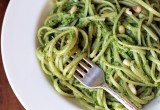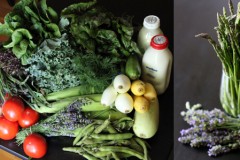I think it was the mix of vibrant sun and biting wind this past weekend that inspired me to finally do something constructive with the bag of dried hot peppers sitting in my pantry. A friend had shared her beautiful stash with me, along with a family recipe for a fantastic-sounding chili; hopefully she won’t mind the project detour I ultimately took with her ingredients.
In truth, I had been contemplating making berbere paste for years–ever since discovering a recipe for it in the pages of the World Food Cafe cookbook in 2002. It seemed so exotic! But then I’d read the long list of ingredients and find myself getting sleepy before even making it into the kitchen. So, as with overly complicated knitting projects and 1,000 piece picture puzzles, it got pushed to the back of the closet, an idea for some rainy day down the line.

A crisp, sunny day offers the perfect opportunity to visit my favorite Punjab Market in Waverly and stock up on spices.
Then a funny thing happened. I bought a small container of a spicy lentil stew from the Ethiopian stall at the Waverly Market and found my motivation: I was going to make a big pot of Yemisir Kik Wot (more on that later).
In truth, making the berbere paste is not actually difficult. It’s just a long list of spices that must be measured and toasted and ground, mixed with a paste of vinegar, onion, ginger, and garlic. After all that, you net a baby food jar’s worth of product–one that you may find yourself opening for no reason other than to breathe in its amazing aromas and dreaming of as you sleep at night.
Berbere Paste
from the World Food Cafe cookbook
2 garlic cloves, peeled and sliced
1/2 inch piece of ginger, minced
3 green onions, sliced
1 T cider vinegar
1/2 tsp. peppercorns
1/2 tsp. cardamom seeds
1/2 tsp. coriander seeds
1/2 tsp. fenugreek seeds
1 tsp. cumin seeds
4 cloves
8 dried red chili peppers
4 tsp. ground sweet paprika
1 tsp. salt
1/4 tsp. ground allspice
1/4 tsp. ground cinnamon
1/4 tsp. ground nutmeg
Measure whole spices into a bowl. Heat a dry skillet and toast them until lightly browned and fragrant. Toss frequently and take care not to burn them. Next, grind the whole spices and dried peppers finely (I use a cheap electric coffee grinder that I reserve just for this purpose). Measure the powdered spices into the mixture as well. Set aside.
Place the garlic, ginger, onions, and vinegar in the bowl of a food processor (since there is so little to mix, after some trial and error, I had much better luck using the small processor that came with my immersion blender as opposed to my powerhouse Cuisinart). Process into a paste, then add all the ground spices and continue mixing till well combined. Pack into a small glass jar with a tight-fitting lid and refrigerate until needed.
Since I had barely dented my Ziploc bag full of dried peppers and I already had every spice I own out on the counter, I decided to just keep going and try my hand at making a batch of Harissa while I was at it (plus, there was a soup using it that I’d just read about and wanted to try…convenient!). After all that berbere paste activity, this one seemed sinfully low-effort.
Harissa
also from the World Food Cafe cookbook
2 oz. dried hot red chilies
2 T cumin seeds
3 T coriander seeds
4 garlic cloves
1 tsp. salt
5 T olive oil
Remove any stems or seeds from dried chilies and soak the peppers in warm water for about an hour.
Meanwhile, measure whole spices into a bowl. Heat a dry skillet and toast them until lightly browned and fragrant. Toss frequently and take care not to burn them. Grind the whole spices finely and set aside.
Once the peppers have softened, drain and place in the bowl of a food processor. Add ground spices, garlic, and salt, and run processor until peppers break down and a paste begins to form (I had to stop and scrape down the bowl repeatedly, and even then only got half way there).
Next, with the processor running, slowly drizzle in the oil. This is where my harissa finally came together, much like a pesto. Keep processing until smooth. Pack into a glass jar with a tight-fitting lid and refrigerate until needed. Works as a condiment and in soups and stews (more on that later, as well).




























Great post! we also have tons of chilies etc. sitting around. The only downside to making a spice mix is you end up with a lot of it, but this seems like a useful way to go. Thanks!
Awesome post!! Love the berebere paste, I’ve been looking for a good recipe for a long time..this seems perfect. Gorgeous photos, you have a wonderful blog!
Thanks to you both!
At first, I was a bit disappointed with the quantity of the berbere paste, but you’re right, 2peasandapot, having a lot would just be a waste in my household and so this low-yield version of the recipe was actually ideal. This way, it will spice a few dishes over the 6-week +/- shelf life and I can move on to other projects till I need some again.
And Ambika, please let me know if you try it and how it works out for you. There are many, many versions out there, of course. I’m especially curious about those that also contain oil and how that helps or hinders storage.
I’ve been exploring Middle Eastern spices lately and actually purchased some ground berbere. I tend to use dried harissa, but have made it once from scratch into a paste…it’s truly fantastic. I agree with you that sometimes, you just want to open up that jar and give it a sniff :)
so glad you posted this! I´ve been looking for harissa and couldn´t find it anywhere and this recipe looks perfect. And the berbere paste is a bonus. Thanks for both!
Thanks, Paula. Let me know how it works for you. I’m still making use of my jar of harissa, most often by swapping out the peppers and adding it as the spicy heat source to the cilantro chutney recipe I love. It renders it doubly addictive, in my opinion.
[…] harissa adaptada de Food Wanderings y Wonderland Kitchen […]
[…] Irish cheese bacon cheesecake (savory take on cheesecake, love it) – Butter chicken – Berbere Paste – Brussels sprouts with Pecans and Avocado (can´t wait to try this recipe) – Red […]
[…] curry adapted from Rasa Malaysia and David Lebovitz harissa adapted from Food Wanderings and Wonderland Kitchen […]